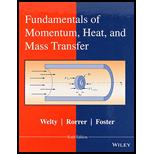
Interpretation: The rate of the temperature increase in the reservoir is to be determined by using the energy balance equation.
Concept introduction: The Energy balance across the pipe is given by the Bernoulli’s equation in which the sum of Potential head, Kinetic head and Pressure head is constant. The Bernoulli equation across 2 points of any system is given by:-
The notations used in equation (1) are:-
P1and P2are pressure at inlet and outlet of the pipe
v1 and v2 are velocity at inlet and outlet of the pipe
Z1 and Z2 are the locations of the liquid.
H = Head developed by the pump
g = Acceleration due to gravity
The amount of heat required is given as,
Q = Heat required
V = Volume of the reservoir
c = Specific heat of the fluid
The change in heat due to head developed is given as,
m = Mass flow rate of the fluid
The mass flow rate from momentum equation is,
A = Area of the pipe
v = Velocity of the fluid
Want to see the full answer?
Check out a sample textbook solution
Chapter 6 Solutions
Fundamentals of Momentum, Heat, and Mass Transfer
- ANSWER ONLY ONE OF THE FOLLOEING QUESTIONS Question 2: 20 marks Answer the following If the pressure losses in the circulation system excluding the bit (Pe) can be related to the flow rate by P=0.02631xQ [P, in psi and Q in gpm]; the maximum Pump pressure (P,) is 5000 psi 1. Find the nearest standard nozzle size to be fitted in the bit necessary to deliver a maximum hydraulic horse power at bit (No of Bit nozzles = = 3)......"10 marks" 2. Find the nearest standard nozzle size to be fitted in the bit necessary to maintain a maximum impact force at bit (No of Bit nozzles = 4)......10 marks"arrow_forwardSolve the questionarrow_forwardSolve the question belowarrow_forward
- 9.5 Comparison of Three Scale-up Methods for a Crystallization A batch crystal- lization of an antibiotic was performed using a volume of 750 ml in the laboratory with a 3.5 cm diameter impeller at a speed of 600 rpm, the minimum speed required to fully suspend the crystals. Estimate the size of the impeller and the impeller speed for scale-up to 250 liters for each of the following three assumptions as a basis for scale-up: (1) constant power per volume, (2) constant impeller tip speed, and (3) full suspension of crystals (at minimum speed).arrow_forward8.3 Fractionation of a Protein Solution Four proteins are dissolved in solution. The constants in the Cohn equation (see Example 8.1) for the proteins are given in Table P8.3 along with the concentration of each protein in solution. Assume that the Cohn equation constants are valid when other proteins are present. (a) Determine the maximum percentage recovery of protein 4 that can be obtained if it is desired to obtain a precipitate containing 100% protein 4. (b) Determine the maximum percentage recovery of protein 3 that can be obtained if it is desired to obtain a mother liquor containing 99% protein 3. TABLE P8.3 Protein β K(M-1) Concentration (g/liter) 1 6.30 2.84 0.3 234 10.20 4.34 0.4 8.60 2.48 5.0 8.00 3.97 10.0arrow_forwardPlease solve 5.2 (a) and (b)arrow_forward
- 3. Review the figure below and mark it to indicate where relief devices should be placed. Nitrogen Purge Hexane Storage Water Polymer Storage Polymer Steam- HIC HIC (TIC) (TIC Hexane Coolers #FIC) (W) (PIC (PIC) PD Pump Centrifuge #FIC)arrow_forward2. Review the figure below and mark it to indicate where relief devices should be placed. Steam- Nitrogen (Purge Gas) Crude Methanol PD Pump HIC ☑D TIC TC Water TIC Still Steam PD Pump Drum LIC PIC Tars Methanolarrow_forwardCalculate the thickness of the square mica plates (in ft), having an area of 0.01 sq. is falling at a velocity of 5.0 cm through oil with a density of 55 lb/cu ft and with viscosity of 15 centipoise. The specific gravity of the mica is 3.0. Assume that the particle velocity reaches its maximum and so it becomes cement was, and stokes law applies.arrow_forward
 Introduction to Chemical Engineering Thermodynami...Chemical EngineeringISBN:9781259696527Author:J.M. Smith Termodinamica en ingenieria quimica, Hendrick C Van Ness, Michael Abbott, Mark SwihartPublisher:McGraw-Hill Education
Introduction to Chemical Engineering Thermodynami...Chemical EngineeringISBN:9781259696527Author:J.M. Smith Termodinamica en ingenieria quimica, Hendrick C Van Ness, Michael Abbott, Mark SwihartPublisher:McGraw-Hill Education Elementary Principles of Chemical Processes, Bind...Chemical EngineeringISBN:9781118431221Author:Richard M. Felder, Ronald W. Rousseau, Lisa G. BullardPublisher:WILEY
Elementary Principles of Chemical Processes, Bind...Chemical EngineeringISBN:9781118431221Author:Richard M. Felder, Ronald W. Rousseau, Lisa G. BullardPublisher:WILEY Elements of Chemical Reaction Engineering (5th Ed...Chemical EngineeringISBN:9780133887518Author:H. Scott FoglerPublisher:Prentice Hall
Elements of Chemical Reaction Engineering (5th Ed...Chemical EngineeringISBN:9780133887518Author:H. Scott FoglerPublisher:Prentice Hall
 Industrial Plastics: Theory and ApplicationsChemical EngineeringISBN:9781285061238Author:Lokensgard, ErikPublisher:Delmar Cengage Learning
Industrial Plastics: Theory and ApplicationsChemical EngineeringISBN:9781285061238Author:Lokensgard, ErikPublisher:Delmar Cengage Learning Unit Operations of Chemical EngineeringChemical EngineeringISBN:9780072848236Author:Warren McCabe, Julian C. Smith, Peter HarriottPublisher:McGraw-Hill Companies, The
Unit Operations of Chemical EngineeringChemical EngineeringISBN:9780072848236Author:Warren McCabe, Julian C. Smith, Peter HarriottPublisher:McGraw-Hill Companies, The





